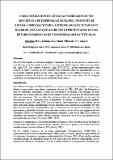Please use this identifier to cite or link to this item:
http://hdl.handle.net/10261/43281Share/Export:
 SHARE
BASE SHARE
BASE
|
|
| Visualizar otros formatos: MARC | Dublin Core | RDF | ORE | MODS | METS | DIDL | DATACITE | |

| Title: | Caracterización de antiguas variedades de vid adscritas a determinadas zonas del noroeste de España. Comparación de la morfología de sus hojas y racimos, con los que aparecen representados en los retablos barrocos de esas mismas áreas vitícolas |
Other Titles: | Characterisation of old vine varieties attached to certain zones of the north-west of Spain. Comparison of the morphology of its leaves and bunches with the ones represented in the baroque altarpieces of the same vine-producing areas | Authors: | Martínez Rodríguez, María del Carmen CSIC ORCID; Santiago Blanco, José Luis CSIC ORCID ; Alonso-Villaverde Iglesias, Virginia CSIC; Gago Montaña, Pilar CSIC ORCID | Keywords: | Ampelografía Patrimonio artístico |
Issue Date: | 2006 | Publisher: | Organisation internationale de la vigne et du vin | Citation: | 29th OIV World Congress of Vine and Wine | Abstract: | [ES] En el NO de España se conservan antiguas variedades de vid, de las que no se conoce ni su procedencia, ni desde cuando existen en esa zona, más allá de algunas referencias que datan del siglo XIX. Los retablos barrocos (siglo XVII-XVIII), poseen representaciones muy realistas de hojas y racimos de vid, constituyendo verdaderas obras de ampelografía. Así, se ha recogido material gráfico de las hojas representadas en los retablos barrocos y se han comparado a través de análisis de imagen digital, con las hojas reales de las antiguas variedades, con el objetivo de buscar similitudes entre ambos. [EN] Due to its antiquity, it is frequent to find references about the vine culture in agricultural writings, holy texts, poetical or literary ones and also in several artistic expressions (such as painting, architecture...). The Mision Biologica de Galicia (CSIC) conserves a group of varieties whose centenary original mother plants are more than 200 or 300 years old. Possibly, they are native and exclusive varieties from the North-West of Spain. However, at the moment it is not possible to date the beginning of its cultivation. In addition to determine the grape and wine-growing features of the varieties, cultural references or traditions related to them, it would help to increase their commercial value. In the early XVII century altarpieces the representation of the vine is very frequent. Stems, leaves and bunches appear represented in the solomonic columns in a high naturalistic sense (Alvarez Fernandez, 2001). Leaves and bunches represented in those columns found in different Galician churches (North-West of Spain) present clearly different morphologies one from another. In some cases it is surprising its similarity with some of the real vine varieties. These altarpieces could be, apart from wonderful art works, a kind of ampelography, with which we could compare some of the unknown varieties conserved in the Mision Biologica de Galicia (CSIC). In the present study, leaves found in altarpieces and real leaves are compared taking into account base parameters measured in both types of leaves (length of the veins in the leaves, distance from the petiole point to the base of the petiole sinus...). |
Description: | 4 hojas, 3 figuras, 2 tablas.- Trabajo presentado en el Congreso celebrado en Logroño (España) entre el 25 y el 30 de junio de 2006. | URI: | http://hdl.handle.net/10261/43281 |
| Appears in Collections: | (MBG) Comunicaciones congresos |
Files in This Item:
| File | Description | Size | Format | |
|---|---|---|---|---|
| Martinez_Caracterizacion_antiguas.pdf | 166,35 kB | Adobe PDF |  View/Open |
CORE Recommender
Page view(s)
296
checked on Apr 24, 2024
Download(s)
158
checked on Apr 24, 2024
Google ScholarTM
Check
WARNING: Items in Digital.CSIC are protected by copyright, with all rights reserved, unless otherwise indicated.
